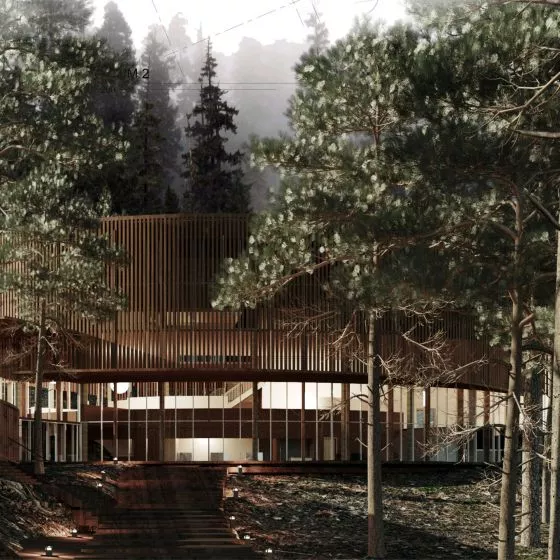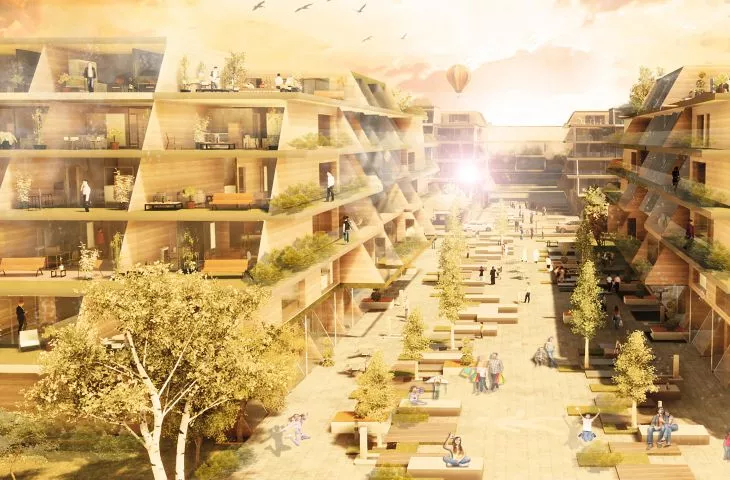Maria Opłatek and Marta Noszczyk are other students of the Faculty of Architecture at Wrocław University of Technology, whose project made it to the finals of the Multi Comfort Student Contest in Paris. The authors transformed the post-factory part of Saint-Denis into a residential area full of greenery and sunshine. "Sunray" was made under the direction of Dr. Tomasz Glowacki of the Department of Architecture and Visual Arts at Wroclaw University of Technology.
project presentation
© Maria Opłatek, Marta Noszczyk
Revitalization of the post-industrial part of Saint-Denis
The task of the competition organized by Multi Comfort Saint Gobain was to transform the post-industrial area of the former Coignet factory into a vibrant and green area, equipped with educational facilities and recreational areas. Participants had to prepare a master plan for the entire project, a residential and educational concept for a part of the area with an elementary school and kindergarten, as well as ideas on how to protect and revitalize the historical buildings located in the designated area. The Polish edition of the competition selected three projects whose authors will represent our country at the finals in Paris. Importantly, two concepts come from the Wroclaw University of Technology. One is Live, work & play in a sustainable way by Justyna Dymytryk and Maja Klawitter, and the other is "Sunray" by Maria Opłatek and Marta Noszczyk.
The estate is arranged around two axes
© Maria Opłatek, Marta Noszczyk
new face of the post-industrial district
The students pointed out that the post-industrial area of Saint-Denis is a multicultural place, inhabited mostly by young people with secondary education. Unemployment there reaches more than 20 percent and mainly affects the young. On top of this, the neighborhood is devoid of organized green space, services and recreational areas, offering poor housing. The answer to these problems is the "Sunray" project, a complex of buildings arranged around two axes: the Residential (residential) and Link Axis (connection axis). The first concentrates around it basic service points, such as offices, a shopping and service center or a school with a kindergarten. The second stretches from the underpass to the metro station, through the cultural facilities created in the revitalized villa, to the footbridge over the Seine, connecting Saint-Denis with neighboring Paris.
The sloping terraces allow for a gradation of floor depths
© Maria Opłatek, Marta Noszczyk
As the authors state:
Our idea is based on solar energy, this allows us to focus as much as possible on the most important issues for us: human comfort and ecology. [...] The terrace-mesonet type of development makes it possible to enjoy the sun all day long. [...] In addition, the galleries make it possible to ensure good ventilation. An important aspect was to create a welcoming environment with high residential standards using sustainable solutions.
Sunny terraces and gradational construction
A distinctive feature of the buildings are the sloping outdoor terraces, allowing for a gradation of floor depths and allowing 24-hour access to natural light, as well as adequate shade. Each of the multi-story mesonet residential buildings has its own underground parking garage with 67 parking spaces, and service outlets in the arcades.
sunny terraces
© Maria Opłatek, Marta Noszczyk
The remaining floors are occupied by modular apartments and common spaces. The apartments with the largest space are located on the lower floors. The higher the floor, the smaller the space of the units. Hence, apartments closer to the first floor are intended for families with children, while those higher up are for couples or singles.
Part of the competition task was also to design a kindergarten-school building. The students proposed a three-story building partly made of factory warehouses, whose structure takes advantage of the natural differences in the terrain. The timber-framed building has interior courtyards, a green roof and numerous glazings.
kindergarten-school building
© Maria Opłatek, Marta Noszczyk
greenery and ecological solutions
The authors introduced greenery into almost every element of the estate's space. They proposed the use of solar panels as a source of energy, natural ventilation, rainwater collection and a triple glazing system to guarantee acoustic comfort for residents. They also calculated that thanks to the solutions used, the annual energy demand of the building would be 14 kWh per square meter, which would place the complex among A+ class buildings.
The final of the competition is planned in Paris in February 2021, where student teams from all over the world will have just a few minutes to convince the jury of their designs. We're keeping our fingers crossed!
compiled by: Dobrawa Bies
illustrations courtesy of Maria Opłatek and Marta Noszczyk























































